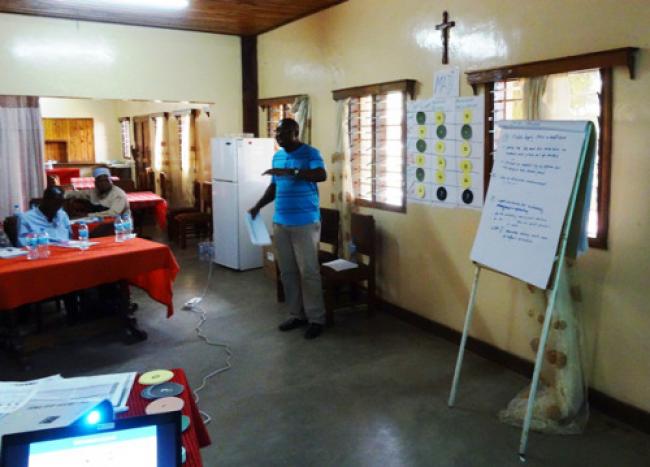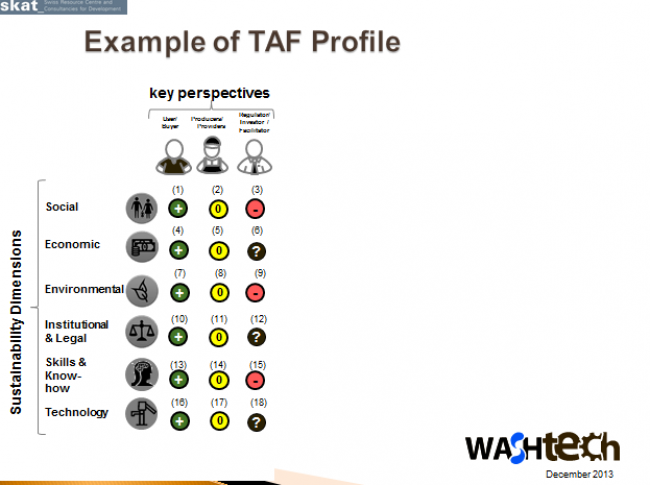The Tanzanian Ministry of Water has adopted the Technology Applicability Framework (TAF) to help make water and sanitation services sustainable. Tanzania is now the seventh country to use this innovative tool, which was developed by the IRC-led WASHTech project.
Published on: 06/04/2015

More than 30% of all water points in Tanzania are not working. One of the measures the government has taken to tackle this problem is the adoption of the Technology Applicability Framework (TAF), reports SKAT’s André Olschewski [1]. This participatory tool, developed by the IRC-led WASHTech project, assesses the applicability and potential sustainability risks of water, sanitation and hygiene (WASH) technologies.
The Tanzanian Ministry of Water has included the TAF in the Project Implementation Manual (PIM) for the 2nd phase of the 2006-2025 national Water Sector Development Programme (WSDP). The manual guides all programme actors at regional and district level including government officials, service providers, the private sector and communities.
The roll out of the Technology Applicability Framework in Tanzania started in 2015 with a 5-day workshop for regional water advisors in February. This was followed in March by a 5-day Training of Trainers for NGOs and suppliers, who applied the TAF to an existing community piped water supply scheme and household latrines in the rural area of Iramba District.
The Technology Applicability Framework has been implemented in at least six other countries besides Tanzania. During the WASHTech project (2011-2013), the methodology was piloted in Burkina Faso, Ghana and Uganda [2]. Since then WaterAid and Welthungerhilfe have used the TAF to assess pour-flush toilets in Nicaragua [3] and the EMAS flexi-pump in Sierra Leone [4]. IRC employed the TAF to assess the application of India Mark II handpumps and solar-powered pumps in South Sudan [5].

An independent evaluation listed WASHTech as one of thirteen ‘remarkable’ innovation projects, out of 85 funded through the European Commission’s FP-7 Environment Programme [6]. The evaluation praised WASHTech for making its two open source products - the TAF and the Technology Introduction Process (TIP) - available to all on the website hosted by RWSN: www.washtechnologies.net.
The WASHTech consortium included the European-based IRC, WaterAid, SKAT Foundation and Cranfield University and the African-based NETWAS, KNUST, TREND and WSA (formerly CREPA).
References
[1] Olschewski, A. Roll out of technology applicability tool in Tanzania to assure sustainable WASH services. RWSN blog, 25 Mar 2015
[2] Technology Applicability Framework & Technology Introduction Process: Case Studies
[3] Casey, V., 2014. Pourflush Toilet in North Atlantic Autonomous Region, Nicaragua. Available at: http://www.washtechnologies.net/en/taf/case-studies/details/28
[4] Gelhard, M., 2014. WASH self-supply in Sierra Leone : perspectives and options. Bonn, Germany: Welthungerhilfe. Available at: http://www.washtechnologies.net/en/taf/documentation/details/596
[5] Terpstra, J,, South Sudan: Development in the youngest country in the world, IRC, 12 May 2015
[6] Helming, K. … [et al.], 2014. Ex-post evaluation of FP7 Cooperation Programme Theme “Environment (including Climate Change)” : report to the European Commission. Brussels, Belgium: European Commission. Available at: http://bit.ly/1c141Pd